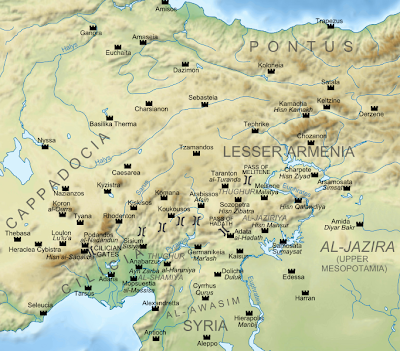I'm on vacation. As I've done in recent years, I've
prepared a number of posts on topics of historical and cultural
interest ahead of time, posts unlikely to be overtaken by events. There
will be one or more of these per day, and I may drop in to comment on
current developments as required.
For four posts now we have examined the question of whether Punic, the Phoenician language of Ancient Carthage and its colonies, survived as a spoken language (presumably alongside Berber and Latin, throughout the life of Roman North Africa. Some have argued that the presence of a Semitic vernacular in North Africa actually made the adoption of Arabic smoother, and some Punic enthusiasts have even gone so far as to argue that Punic influence can still be found in the spoken dialects (darija) of North Africa, along with Maltese (which, though today considered a separate language, has a grammatical structure comparable to North African Arabic dialects, though its Semitic vocabulary includes many borrowings from Romance and from Greek). Let's look at each of these assertions in turn.
It has often been noted that while the Arab conquests swept as far east as India and Central Asia and as far west as southern France, Arabic did not become the spoken language in all of that vast area; though Iran, India, and Central Asia became permanently Muslim, they retained or soon regained their original Persian, Turkic, or Indic vernaculars, though with a large input of religious and legal terms from Arabic. (Even in areas that did not remain Muslim, Arabic had a lasting influence; consider the huge presence of Arabic-based words in Spanish, and the entire Maltese language.) But neither did Arabic remain limited to the Arabian Peninsula: it became firmly established from the Strait of Gibraltar to the Persian/Arab Gulf.
As far back as the era of Ernest Renan the idea was floated that Arabic remained established in those areas which already spoke a closely related language. Renan was an early comparative Semiticist; today the Semitic languages are understood not as a separate language family but as a sub-family of closely-related languages within the broader "Afro-Asiatic" language family (comparable to the way the Romance or Germanic or Iranian languages are embraced within the broader Indo-European famiily).
Although non-Semitic languages have always existed in the Levant and Iraq (Sumerian, Hittite, Armenian), it is indisputable that for more than a millennium before Arabic spread outside the Arabian Peninsula, closely related Semitic languages were dominant: first Akkadian/Assyrian/Babylonian, and later Aramaic/Syriac. There is little doubt that the spread of Arabic was greatly aided by the prior presence of a closely related language in Aramaic/Syriac; the Nabatean script, for example, originally was used to write Aramaic but gradually adapted to Old North Arabian, the immediate ancestor of Classical Arabic. And early Arabic was sometimes written in the Syriac alphabet, the texts known as Karshuni in Arabic (Garshuni in Syriac). Arabic simply supplanted (though to this day not completely, for we have discussed modern Aramaic here frequently) the older, closely related language. In Jewish communities across the Arab world, various forms of Judeo-Arabic supplanted or were established alongside Hebrew and Aramaic.
The establishment of Arabic in Egypt and North Africa raises other questions, though. Last August my vacation postings examined why Coptic, which once was more entrenched than Aramaic, had died out as a spoken language while Aramaic has not. There are multiple reasons, but clearly Egypt is an Arabic-speaking country with only small pockets of Nubian and Siwi Berber speakers. If Arabic only took hold where Semitic languages were spoken, Egypt would seem to be a huge exception. And so would the rest of North Africa, though the survival of the Amazigh or Berber languages in the Maghreb show that Arabic is not as thoroughly entrenched as it is in Egypt. To this Maghrebists such as Georges and William Marçais and others have pointed to the survival of Punic as a factor facilitating the adoption of Arabic. But Punic was never spoken in Egypt, so what about Egypt?
Ancient Egyptian, and its later form Coptic, are not unrelated to Semitic; like the Berber languages and some other Saharan languages they are part of the broader Afro-Asiatic family, so one could say that Arabic took root because the languages were still related; that could also apply to the Berber languages of North Africa, regardless of any Punic survival. The Berber languages, while Afro-Asiatic, are much farther removed from the Semitic group than is Egyptian. Though not itself considered part of the Semitic sub-family, Egyptian has features that seem more Semitic than other Afro-Asiatic languages outside the Semitic group. Some basic vocabulary (including numerals an pronouns) are closely kin, as are some triliteral roots.
This question of whether Arabic put down deeper roots where Semitic languages were already spoken underlies much of the debate about the survival of Punic, and you can find, for example, an online discussion of some of the issues here.
But the question of Punic does not end with whether its survival made the adoption of Arabic easier. There are those who argue that a Punic substratum can still be identified in the colloquial dialects of North Africa (plus Maltese). At first glance this seems extreme, but there is definitely a detectable Coptic substratum in colloquial Egyptian, and plenty of Berber loan-words in North African Arabic; could there be a Punic substratum as well? This argument today is primarily identified with the Algerian-born linguist Abdou Elimam, who is a strong advocate of treating the darija of the Maghreb as languages independent of if related to Standard Arabic.
At least one of Elimam's articles on Punic influence on Maghrebi can be found online: Du Punique au Maghribi: Trajectoires d’une langue sémito-méditerranéenne, published in Synergies Tunisie No. 1, 2009, pp. 29-38. The article (obviously) is in French, and while I believe he has written more extensively on this subject, I presume this summarizes his arguments.
Now Elimam is a Sorbonne-trained linguist and I certainly am neither, nor do I find anything impossible about the idea of an identifiable substratum of Punic in Maghrebi dialects of Arabic, but I am struck by several things. First, there is the rather tiny corpus of actual Punic texts, most of which tend to be tombstones, funerary inscriptions, and the like; Punic is a form of Phoenician but the total corpus of Phoenician texts is not great either, and the fact that we know as much as we do about either language is based in part on their extremely close resemblance to Hebrew. And all of these language are themselves relatively close to Arabic.
At the end of his article, Elimam presents a table showing vocabulary in common between Punic and Maghribi. These include Ab for father, Um for mother, bny for build, and so on. But wait: those are all good Arabic as well as good Canaanite (though modern Hebrew pronounces the first as Av today). For life he notes the similarity between Punic hayim and "Maghribi" hayat, but the latter is of course perfectly good Arabic as well. (To be fair, not all his examples are this obviously equivalent to Standard Arabic, but most are.) I have to say that this particular article doesn't completely convince me, but perhaps if I read more of his work I'd be persuaded.
UPDATE: By happy coincidence, Lameen Souag just addressed Elimam's claims as well, as he notes in a comment below, though the blogpost is in darija.
I know this long discussion of Punic and Arabic may not have been everybody's cup of tea; on to other subjects in my remaining vacation posts, and back to normal blogging on Monday.

























